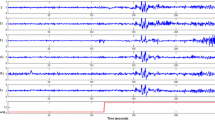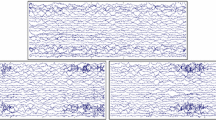Abstract
Accurate automated seizure detection remains a desirable but elusive target for many neural monitoring systems. While much attention has been given to the different feature extractions that can be used to highlight seizure activity in the EEG, very little formal attention has been given to the normalization that these features are routinely paired with. This normalization is essential in patient-independent algorithms to correct for broad-level differences in the EEG amplitude between people, and in patient-dependent algorithms to correct for amplitude variations over time. It is crucial, however, that the normalization used does not have a detrimental effect on the seizure detection process. This paper presents the first formal investigation into the impact of signal normalization techniques on seizure discrimination performance when using the line length feature to emphasize seizure activity. Comparing five normalization methods, based upon the mean, median, standard deviation, signal peak and signal range, we demonstrate differences in seizure detection accuracy (assessed as the area under a sensitivity–specificity ROC curve) of up to 52 %. This is despite the same analysis feature being used in all cases. Further, changes in performance of up to 22 % are present depending on whether the normalization is applied to the raw EEG itself or directly to the line length feature. Our results highlight the median decaying memory as the best current approach for providing normalization when using line length features, and they quantify the under-appreciated challenge of providing signal normalization that does not impair seizure detection algorithm performance.







Similar content being viewed by others
Notes
The records used are: chb01_03, chb01_04, chb01_15, chb01_16, chb01_18, chb03_01, chb03_02, chb03_03, chb03_04, chb03_34, chb05_06, chb05_13, chb05_16, chb05_17, chb05_22.
In contrast “AND” systems require multiple channels to detect a candidate seizure at the same time for a seizure event to be marked.
References
Casson AJ, Rodriguez-Villegas E (2009) Toward online data reduction for portable electroencephalography systems in epilepsy. IEEE Trans Biomed Eng 56(12):2816–2825
Casson AJ, Luna E, Rodriguez-Villegas E (2009) Performance metrics for the accurate characterisation of interictal spike detection algorithms. J Neurosci Methods 177(2):479–487
Casson AJ, Yates DC, Smith SJ, Duncan JS, Rodriguez-Villegas E (2010) Wearable electroencephalography. IEEE Eng Med Biol Mag 29(3):44–56
De Clercq W, Vergult A, Vanrumste B, Van Paesschen W, Van Huffel S (2006) Canonical correlation analysis applied to remove muscle artifacts from the electroencephalogram. IEEE Trans Biomed Eng 53(12):2583–2587
Esteller R, Echauz J, Tcheng T, Litt B, Pless B (2001) Line length: an efficient feature for seizure onset detection. In: IEEE EMBC, Istanbul
Goldberger AL, Amaral LAN, Glass L, Hausdorff JM, Ivanov PC, Mark RG, Mietus JE, Moody GB, Peng CK, Stanley HE (2000) PhysioBank, PhysioToolkit, and PhysioNet: components of a new research resource for complex physiologic signals. Circulation 101(23):e215–e220
Goncharova II, McFarland DJ, Vaughan TM, Wolpaw JR (2003) EMG contamination of EEG: spectral and topographical characteristics. Clin Neurophysiol 114(9):1580–1593
Greene BR, Faul S, Marnane WP, Lightbody G, Korotchikova I, Boylan GB (2008) A comparison of quantitative EEG features for neonatal seizure detection. Clin Neurophysiol 119(6):1248–1261
Harner RN (2009) Automatic EEG spike detection. Clin EEG Neurosci 40(4):262–270
Jain A, Nandakumara K, Ross A Score normalization in multimodal biometric systems. Pattern Recognit 38(12) 2270–2285
Kim H, Rosen J (2010) Epileptic seizure detection—an AR model based algorithm for implantable device. In: IEEE EMBC, Buenos Aires, pp 5541–5544
Kuhlmann L, Cook MJ, Fuller K, Grayden DB, Burkitt AN, Mareels IMY (2008) Correlation analysis of seizure detection features. In: ISSNIP, Sydney, pp 309–314
Kuhlmann L, Burkitt A, Cook M, Fuller K, Grayden D, Seiderer L, Mareels I (2009) Seizure detection using seizure probability estimation: comparison of features used to detect seizures. Ann Biomed Eng 37(10):2129–2145
Logesparan L, Rodriguez-Villegas E (2011) A novel phase congruency based algorithm for online data reduction in ambulatory EEG systems. IEEE Trans Biomed Eng 58(10):2825–2834
Logesparan L, Casson AJ, Rodriguez-Villegas E (2011) Assessing the impact of signal normalization: preliminary results on epileptic seizure detection. In: IEEE EMBC, Boston, pp 1439–1442
Logesparan L, Casson AJ, Rodriguez-Villegas E (2012) Optimal features for online seizure detection. Med Biol Eng Comput 50(7):659–669
Logesparan L, Imtiaz SA, Casson AJ, Aguilar-Pelaez E, Rodriguez-Villegas E (2012) A 1.8 mW 12 channel wireless seizure detector for miniaturized portable EEG systems. In: uHealthcare, GyeoungJu
Logesparan L, Casson AJ, Rodriguez-Villegas E (2012) Improving seizure detection performance reporting: analysing the duration needed for a detection. In: IEEE EMBC, San Diego
McEvoy RP, Faul S, Marnane WP (2010) Ambulatory REACT: real-time seizure detection with a DSP microprocessor. In: IEEE EMBC, Buenos Aires
Meier R, Dittrich H, Schulze-Bonhage A, Aertsen A (2008) Detecting epileptic seizures in long-term human EEG: a new approach to automatic online and real-time detection and classification of polymorphic seizure patterns. J Clin Neurophysiol 25(3):119–131
Osorio I, Frei MG, Wilkinson SB (1998) Real-time automated detection and quantitative analysis of seizures and short-term prediction of clinical onset. Epilepsia 39(6):615–627
Patel K, Chern-Pin C, Fau S, Bleakley CJ (2009) Low power real-time seizure detection for ambulatory EEG. In: Pervasive Health, London
Raghunathan S, Gupta SK, Markandeya HS, Roy K, Irazoqui PP (2010) A hardware-algorithm co-design approach to optimize seizure detection algorithms for implantable applications. J Neurosci Methods 193(1):106–117
Rechtschaffen A, Kales A (eds) (1968) A manual of standardized terminology, techniques and scoring system for sleep stages of human subjects. Public Health Service, US Government Printing Office, Washington
Shoeb A (2009) Application of machine learning to epileptic seizure onset detection and treatment. PhD thesis, Massachusetts Institute of Technology
Smith PEM, Wallace SJ (2001) Clinicians’ guide to epilepsy. Arnold, London
Temko A, Thomas E, Marnane W, Lightbody G, Boylan G (2011) Performance assessment for EEG-based neonatal seizure detectors. Clin Neurophysiol 122(3):474–482
Tito M, Cabrerizo M, Ayala M, Jayakar P, Adjouadi M (2009) Seizure detection: an assessment of time- and frequency- based features in a unified two-dimensional decisional space using nonlinear decision functions. J Clin Neurophysiol 26(6):381–391
van Putten MJAM (2003) Nearest neighbor phase synchronization as a measure to detect seizure activity from scalp EEG recordings. J Clin Neurophysiol 20(5):320–325
van Putten MJAM, Kind T, Visser F, Lagerburg V (2005) Detecting temporal lobe seizures from scalp EEG recordings: a comparison of various features. Clin Neurophysiol 116(10):2480–2489
Vergult A, De Clercq Q, Palmini A, Vanrumste B, Dupont P, Van Huffel S, Van Paesschen W (2007) Improving the interpretation of ictal scalp EEG: BSS-CCA algorithm for muscle artifact removal. Epilepsia 396(5):950–958
Yoo J, Yan L, El-Damak D, Altaf MAB, Shoeb AH, Chandrakasan AP (2013) An 8-channel scalable EEG acquisition SoC with patient-specific seizure classification and recording processor. IEEE J Solid-State Circuits 48(1):214–228
Acknowledgments
The research leading to these results has received funding from the European Research Council under the European Community’s 7th Framework Programme (FP7/2007-2013)/ERC grant agreement no. 239749. The work of A. J. Casson was in part supported by the Junior Research Fellowship of Imperial College London.
Author information
Authors and Affiliations
Corresponding author
Electronic supplementary material
Below is the link to the electronic supplementary material.
Rights and permissions
About this article
Cite this article
Logesparan, L., Rodriguez-Villegas, E. & Casson, A.J. The impact of signal normalization on seizure detection using line length features. Med Biol Eng Comput 53, 929–942 (2015). https://doi.org/10.1007/s11517-015-1303-x
Received:
Accepted:
Published:
Issue Date:
DOI: https://doi.org/10.1007/s11517-015-1303-x




